Risk Assessment Studies
Report No.9
MICROBIOLOGICAL
RISK ASSESSMENT ON
SALADS IN HONG KONG
July 2002
Food and Environmental Hygiene Department
HKSAR
Correspondence:
Risk Assessment Section
Food and Environmental Hygiene Department
43/F, Queensway Government Offices,
66 Queensway, Hong Kong
Email: enquiries@fehd.gov.hk
Table of Contents
- Abstract
- Objective
- Introduction
- Production of Salads
- Potential Microbiological Hazards
- Microbiological Surveillance on Salads
- Results
- Specific Pathogens
- International Comparison
- Hygienic Quality
- Discussion
- Conclusion & Recommendations
- Advice to Trade
- Advice to Consumers
- Reference
- Figure 1: Microbiological Surveillance Results of Salads – Specific Pathogens (1999-2001)
- Figure 2: Microbiological Surveillance Results of Salads – ACC (1999 – 2001)
- Figure 3: Aerobic Colony Count of Salads (1999 – 2001)
- Figure 4: Distribution Curve of Aerobic Colony Count of Salads (1999 – 2001)
- Figure 5: Microbiological Surveillance Results of Salads – E. coli (total) count (1999 – 2001)
- Table 1: Microbiological Surveillance Results of Salads – Specific Pathogens (1999 –2001)
- Table 2: Summary of Unsatisfactory Results – Specific Pathogens (1999-2001)
- Table 3: Summary of Studies on Microbiological Status on Salads Conducted by Other Countries
- Table 4: Microbiological Surveillance Results of Salads – ACC (1999 – 2001)
- Table 5: Breakdown of Unsatisfactory Results by Type of Premises – ACC (1999 – 2001)
- Table 6: Microbiological Surveillance Results of Salads – E. coli (total) count (1999 – 2001)
- Annex I: Flow Chart of Salads Production
- Annex II: Microbiological Guidelines for Salads
Risk Assessment Studies
Report No.9
MICROBIOLOGICAL
RISK ASSESSMENT ON
SALADS IN HONG KONG
Abstract
Recently, salads have become popular among consumers in Hong Kong. Many different styles of salads are commercially available in the market. In commercial settings, salads are either freshly prepared at restaurants or produced as pre-packaged food at food factories for supplies to retail outlets. Some restaurants have self-serve salad bars and food ingredients displayed there may be of additional risk of being contaminated by the patronizing customers. In reviewing the microbiological surveillance findings of 573 salad samples collected from 1999 through 2001 by the Food Surveillance Programme, 10 (1.7%) out of 573 samples exceeded the levels set out in the FEHD's Microbiological Guidelines for Ready-to-eat Food in terms of specific pathogens. Listeria monocytogenes was isolated in 6 (1.0%) of these samples and Salmonella spp. was isolated in the other 4 (0.7%) samples. With respect to hygienic quality, during the past 3 years, 63 (24.9%) out of 253 samples and 3 (1.3%) out of 239 samples were found unsatisfactory and exceeded the hygienic quality level of Aerobic Colony Count and E.coli (total) count respectively. Salad preparation often involves handling of pre-cooked or ready-to-eat ingredients with little or no further cooking steps to reduce the microbiological risk. Therefore, improper handling of ingredients and contamination after processing are the two main pathways to contaminate the final products. Both the trade and consumers are advised to take necessary precautions to enhance food safety in preparation and consumption of salads.
Risk Assessment Studies
Report No.9
Microbiological Risk Assessment on Salads in Hong Kong
OBJECTIVE
The aim of this paper is to evaluate the microbiological risk of salads in Hong Kong.
INTRODUCTION
2. Saladsare mixtures of minimally processed ready-to-eat vegetables[a]with or without dressing[b]. Other common ingredientsare fruits, poultry, meat, seafood, egg, pasta, herbs,nuts and cooked vegetables. Salads are usuallyserved cold.
3. The ingredients for making salads usually impart fresh-likequality characteristics. In addition to suchdesirable quality, the consumption of fresh vegetablesand fruits is increasing as consumers strive to eathealthy diets and benefit from the year-round availabilityof these products that up until recently were consideredto be seasonal. Recently, salads have becomepopular among consumers in Hong Kong. Many differentstyles of salads are commercially available in themarket. Where restaurants served various kindsof salads usually as appetizers, pre-packaged saladssupplied by food factories are also commonly availablein supermarkets and restaurants with take away service.
[a] Minimally processed ready-to-eat vegetables consist of raw vegetables that have been washed, peeled, sliced, chopped or shredded.
[b] Typical salad dressings include mayonnaise, thousand island sauce, French dressing, Italian dressing, etc..
Production of Salads
4. The production of salads includes steps in purchasingand processing of raw materials, mixing of ingredients,packaging, transportation and sale. The generalproduction of salads is illustrated in the flowchartat Annex I.
5. Major ingredients are minimally processed ready-to-eatvegetables that have been washed, peeled, sliced,chopped and shredded. Some of the raw materials,like poultry, meat, seafood, egg and pasta have tobe cooked first. Others such as canned products,herbs, nuts and dressings are usually readily availablefor immediate use.
6. Salads may be served with or without dressing dependingon consumers' preference. Some types of saladsconsist of ingredients mixed with dressings. Other types of salads, or in case of pre-packagedsalads, may contain ingredients only and a separatepackage of dressing is available for consumers tomix with the ingredients by themselves. Saladdressings usually impart characteristic flavours andmay contribute some preservative effect to the productto a certain extent.
7. Large fast food chain stores usually purchase pre-preparedraw materials which only required a mixing procedurebefore serve. Other food premises may purchaseand prepare the salad ingredients by themselves.
8. The finished products may be served on the premises. Otherwise, the fresh-made salads may be packaged andsold in restaurants with take-away service or packagedin food factory and delivered to retail outlets orsupermarkets for sale.
9. Some restaurants have self-serve salad bars wherecustomers can pick ingredients of their choice tomake up their own dishes. Food ingredients displayedat self-serve salad bars may be of additional riskof being contaminated by the patronizing customers.
Potential Microbiological Hazards
10. Microbial pathogens associated with minimally processedready-to-eat vegetables include those occur naturallyin soil such as Listeria monocytogenes, Clostridiumperfringens, Bacillus cereus and those from faecesof human or animal origin such as Salmonellaspp..1 The possiblesources of pathogens in these products include theincoming raw vegetables themselves, the food handlersand the processing environment. When vegetablesare chopped and shredded, the release of plant cellularfluids provides a nutritive medium in which microorganismscan grow. The high moisture content of freshvegetables, the lack of a lethal process to eliminatemicrobial pathogens and the potential for time andtemperature abuse during preparation, distributionand handling further intensify the risk of foodborneillness.2
11. Raw egg is known to be a source of Salmonella. This pathogen may be introduced into the final productif raw and unpasteurized eggs or egg products areused to prepare salad dressings.
12. As salad preparation often involves handling of pre-cookedor ready-to-eat ingredients, good personal and environmentalhygiene practices should be observed to minimize thechance of introduction of microbial hazards.
MICROBIOLOGICAL SURVEILLANCE ONSALADS
13. The Food and Environmental Hygiene Department (FEHD)has a Food Surveillance Programme in place for foodsurveillance and enforcement purposes. Foodsamples were collected at every stage of the supplyprocess from the local market for chemical, microbiologicaland radiological testing. Microbiological testswere conducted by the Pathology Service of the Departmentof Health. Microbiological examination resultsof salads obtained in 1999 to 2001 were extractedfrom the food surveillance database and were reviewedand analyzed in the present study. The microbiologicaltests included those for specific pathogens as wellas for hygienic quality.
14. The results were evaluated based on the MicrobiologicalGuidelines for Ready-to-eat Food recommended by thisDepartment (Annex II).3
RESULTS
15. From 1999 to 2001, a total of 573 salad samples weretaken for microbiological examination for specificpathogens and hygienic indicator microorganisms.
Specific Pathogens
16. "Specific pathogens" refer to bacteria that may causefood poisoning or other illnesses. To safeguardpublic health, salads should not contain specificpathogens exceeding the levels as detailed in theFEHD's Microbiological Guidelines for Ready-to-eatFood (Annex II).3
17. Ten (1.7%) out of 573 samples were found unsatisfactoryin terms of specific pathogens. The numbersof unsatisfactory samples were 2 (1.2%) out of 169samples in 1999, 7 (3.6%) out of 194 samples in 2000and 1 (0.5%) out of 210 samples in 2001 respectively(Table 1, Figure 1).
Table 1: Microbiological Surveillance Results ofSalads – Specific Pathogens
(1999 – 2001)
| Year | Total Number of Sample | Number of Unsatisfactory Sample (%) |
|---|---|---|
| 1999 | 169 | 2 (1.2%) |
| 2000 | 194 | 7 (3.6%) |
| 2001 | 210 | 1 (0.5%) |
| 1999 – 2001 | 573 | 10 (1.7%) |
Figure 1: Microbiological Surveillance Results ofSalads – Specific Pathogens
(1999 – 2001)
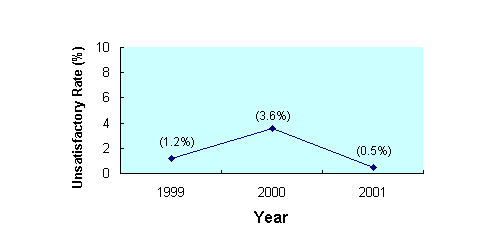
18. As regards the types of pathogens isolated, Listeriamonocytogenes was detected in 6 of these samples,whereas Salmonella spp. was isolated in theother 4 samples (Table 2).
Table 2: Summary of Unsatisfactory Results – SpecificPathogens (1999 – 2001)
| Year | Pathogens Isolated (Number of Samples) |
|---|---|
| 1999 | Salmonella spp. (1) Listeria monocytogenes (1) |
| 2000 | Salmonella spp. (2) Listeria monocytogenes (5) |
| 2001 | Salmonella spp. (1) |
International Comparison
19. Several studies in relation to the microbiologicalstatus of salads and salad vegetables were reportedin a World Health Organization (WHO) review documenton fruits and vegetables eaten raw which was publishedin 1998.4 The Public Health Laboratory Service (PHLS) of theUnited Kingdom had also conducted a study in 2001on the microbiological quality of retail-preparedprepackaged ready-to-eat salad vegetables.5 Table 3 summarized the results of these studies.
Table 3: Summary of Studies on MicrobiologicalStatus on Salad Conducted by Other Countries
| Items | Country | Pathogen | Prevalence |
|---|---|---|---|
| Prepacked salads * | Northern Ireland | Listeria monocytogenes | 3/21 (14.3%) |
| Salad vegetables * | Canada | Listeria monocytogenes | 6/15 (40%) |
| Salad vegetables * | Germany | Listeria monocytogenes | 6/163 (2.3%) |
| Salad vegetables * | Spain | Listeria monocytogenes | 21/70 (30%) |
| Salad greens * | Egypt | Salmonella spp. | 1/250 (0.4%) |
| Prepackaged ready-to-eat salad vegetables † | United Kingdom | Listeria monocytogenes Salmonella spp. | 953/3851 (24.7%) 5/3851 (0.13%) |
* Extracted from the WHO ReviewReport of Fruits and Vegetables Eaten Raw.
†Extracted from the PHLS study.
Hygienic Quality
20. Hygienic quality of food is reflected by the AerobicColony Count and E. coli (total) count.
Aerobic Colony Count (ACC)
21. ACC is useful for indicating the overall microbiologicalquality of a food product. Generally, it doesnot relate to food safety hazards, but acts as anindicator for food quality, shelf-life and post-heatprocessing contamination. The quality levelof ACC for salad recommended by this Department isnot more than 106 colony-forming unit (cfu)per gram of food (Annex II).3
22. From 1999 to 2001, 253 salad samples were tested forACC and 63 (24.9%) had unsatisfactory levels. The numbers of unsatisfactory samples were 18 (21.2%)out of 85 samples in 1999, 16 (21.1%) out of 76 samplesin 2000 and 29 (31.5%) out of 92 samples in 2001 respectively(Table 4, Figure 2).
Table 4: Microbiological Surveillance Results ofSalads – ACC (1999 – 2001)
| Year | Total Number of Testing | Number of Unsatisfactory Result (%) |
|---|---|---|
| 1999 | 85 | 18 (21.2%) |
| 2000 | 76 | 16 (21.1%) |
| 2001 | 92 | 29 (31.5%) |
| 1999 – 2001 | 253 | 63 (24.9%) |
Figure 2: Microbiological SurveillanceResult of Salads – ACC (1999 – 2001)
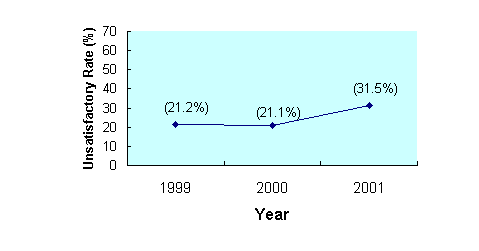
23. A breakdown of the unsatisfactory results of ACC wastabulated in Table 5.
Table 5: Breakdown of Unsatisfactory Results by Typeof Premises – ACC (1999 – 2001)
 |
1999 | 2000 | 2001 | ||||
|---|---|---|---|---|---|---|---|
| No. of samples taken | No. of unsatisfactory sample (%) | No. of samples taken | No. of unsatisfactory sample (%) | No. of samples taken | No. of unsatisfactory sample (%) | ||
| Restaurant | 64 | 14 (21.9%) | 60 | 10 (16.7%) | 70 | 26 (37.1%) | |
| Others | 21 | 4 (19.0%) | 16 | 6 (37.5%) | 22 | 3 (13.6%) | |
| Total | 85 | 18 (21.2%) | 76 | 16 (21.1%) | 92 | 29 (31.5%) | |
24. The distribution of ACC in salads was studied (Figure3). It is shown that 97 (38.3%) out of 253 samplesfall within values of log10 ACC range from5.00 to 5.99, in which the upper range representsthe margin for satisfactory level.
Figure 3: Aerobic Colony Count of Salads (1999-2001)
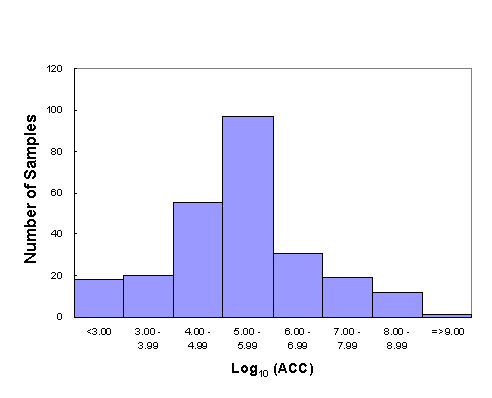
25. When the results are stratified by years, it can beseen that the distribution patterns for the threeyears are quite similar (Figure 4).
Figure 4: Distribution Curve of Aerobic ColonyCount of Salads (1999-2001)
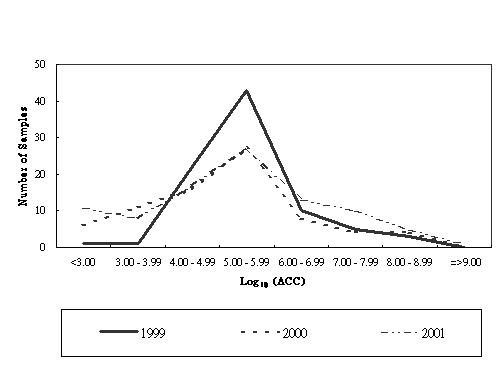
E. coli (total) count
26. The presence of E. coli in foods generallyindicates direct or indirect contamination from faecalorigin. Substantial numbers of E. coliin food suggest a general lack of cleanliness in handlingand improper storage. Its presence does notconnote directly the presence of a pathogen, but impliesa certain risk that may present. The qualitylevel of E. coli recommended by this Departmentfor salad is a total count of not more than 100 cfuper gram of food (Annex II).3
27. During 1999 to 2001, 239 salad samples were testedfor E. coli and 3 (1.3%) were found unsatisfactory. The numbers of unsatisfactory samples were 2 (2.4%)out of 83 samples in 1999, 0 (0%) out of 66 samplesin 2000 and 1 (1.1%) out of 90 samples in 2001 respectively(Table 6, Figure 5).
Table 6: Microbiological Surveillance Results of Salads– E. coli (total) count
(1999 – 2001)
| Year | Total Number of Testing | Number of Unsatisfactory Result (%) |
|---|---|---|
| 1999 | 83 | 2 (2.4%) |
| 2000 | 66 | 0 (0%) |
| 2001 | 90 | 1 (1.1%) |
| 1999 – 2001 | 239 | 3 (1.3%) |
Figure 5: Microbiological Surveillance Results ofSalads –E. coli (total) count
(1999 – 2001)
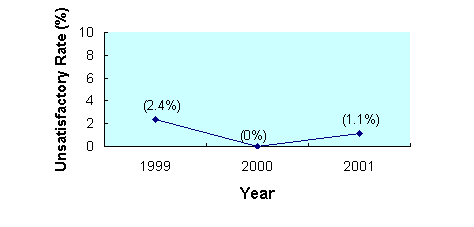
DISCUSSION
28. Listeria monocytogenes and Salmonellaspp. could be introduced by food handlers and cross-contaminationbetween ready-to-eat and raw items.
29. Listeria monocytogenes was found in 6 of the10 unsatisfactory samples for specific pathogens. Listeria monocytogenes is naturally found insoil and in decaying vegetables and can grow on saladvegetables such as lettuce at temperatures as lowas 5°C.6,7 As for Salmonella, the possible routes of contaminationinclude direct contamination of the pre-harvestedvegetables or fruits from faeces of birds and animals,the use of manure or sewage as fertilizer, or theuse of contaminated waters for irrigation of the crops. Raw egg is also known to be a source of Salmonella. This pathogen may be introduced into the final productif raw unpasteurized eggs or egg products are usedto prepare salad dressings. Salmonellamay multiply in the finished products if ambient conditionssuch as nutrient contents, pH value and water activityfavour their growth. It is therefore of paramountimportance to wash the salad vegetables thoroughlyto reduce the microbiological hazards. Properchilling of the salad items at 4°C or below is alsoessential to reduce microbial growth. The riskof Salmonella contamination by raw eggs canbe reduced by using pasteurized eggs or egg productsto prepare salad dressings.
30. Reports of several overseas studies regarding themicrobiological quality of salads showed that theprevalence of pathogens was variable. It hasbeen reported that the proportion of samples contaminatedwith Listeria monocytogenes ranged from 2.3%to 40%, and that contaminated with Salmonellaspp. ranged from 0.13% to 0.4%. Our local surveillanceresults for Listeria monocytogenes comparefavorably with those from overseas, with local prevalenceof 1.0% (6 out of 573 samples) for Listeria monocytogenesin salads during 1999 to 2001. For Salmonellaspp., the local prevalence was 0.7% (4 out of573 samples), which is also comparable with overseasfindings.
31. More than one-third (38.3%) of salad samples weretested to have marginal levels of ACC (≥105 to < 106 cfu) which areapproaching the unsatisfactory level. As ACCis an indicator of overall hygienic quality of theproduct, good hygiene practices that are essentialto improve the hygienic quality of salads should thereforebe strengthened.
32. It is observed that there was an increase in unsatisfactoryrate with respect to ACC in 2001. Analysis revealedthat the increase was mainly contributed by samplestaken from restaurants. As a great variety offoods were handled, processed and served by food handlersat restaurants, it is likely that cross-contaminationbetween ready-to-eat and raw food items could contributeto the higher levels of ACC.
33. Samples found unsatisfactory with E. coli (total)count might be due to faecal contamination of saladcrops. Such contamination might occur at thepre-harvested stage by way of using manure as fertilizersor using contaminated water for irrigation. Faecal contamination might also be introduced by foodhandlers if personal hygiene is not strictly observed.
34. Vegetables and fruits which are subject to processessuch as peeling, slicing, chopping and shredding willremove the natural protective barriers of the intactplant and open the possibility for providing a suitablemedium for the growth of microorganisms. Theseproducts are then eaten without a further heat processingstep. It is therefore of paramount importancethat these products should be washed thoroughly tominimize the microbiological hazards. Disinfectantsmay be applied to reduce the number of microorganismson foods. However, when such chemical is used,the instructions from the suppliers of the disinfectantsmust be followed to prevent any chemical hazard beingintroduced into the final products.
35. Acid salad dressings such as mayonnaise may contributesome preservative effect to foods due to its relativelylow pH. However, such preservative effect willdepend on the initial contamination of the salad,the pH, presence of nutrients (sugars), etc.. The concentration of acetic acid (from vinegar) andthe low pH of salad dressings are the major contributorsto their anti-microbial properties. In caseof mayonnaise, a total formula pH of less than orequal to 4.1 is essential to inactivate Listeriamonocytogenes, Salmonella spp. in the dressing.8,9,10However,proper chilling of mayonnaise-based salad directlyafter production is important to provide protectionagainst growth of microorganisms.11 To be on the safe side, it is recommended to use onlypasteurized eggs or egg products as an ingredientto produce salad dressings.
36. Food ingredients displayed at self-serve salad barsmay be of additional risk of being contaminated bythe patronizing customers. Storage temperatureof the ingredients should be kept at 4°C or below. Sufficient numbers of tongs or ladles with suitablylong handles should be provided and they should bereplaced at a sufficient frequency (e.g. at 4 hoursinterval). Contaminated tongs and ladles (e.g.those dropped onto the floor) should be replaced withclean ones immediately. The salad bar area shouldbe supervised by trained staff to prevent contaminationof foods by customers.
CONCLUSION & RECOMMENDATIONS
37. To improve the hygienic quality of salads, good manufacturingand handling practices should always be observed bythe trade especially for restaurants providing self-servesalad bars. For consumers, they should observehygiene rules to minimize the potential microbiologicalhazards. The followings are some recommendations.
Advice to Trade
- Handling of raw materials:
- Purchase raw materials from reputable and reliable suppliers.
- Wash all vegetables and fruits thoroughly.
- Cook egg, poultry, meat and seafood thoroughly.
- Use pasteurized eggs or egg products to prepare salad dressings.
- Store salad dressings at 4°C or below once their packages are opened.
- Avoid holding chilled ingredients (e.g. meat, seafood, cut fruits and vegetables) and finished products at above 4°C for more than 2 hours.
- Self-serve salad bars
- Display salad ingredients in a proper manner and at 4°C or below.
- Provide sufficient number of tongs or ladles with long handles and replace them with clean ones when appropriate (e.g. at 4 hour interval). Remove contaminated tongs and ladles (e.g. those dropped onto the floor) from the salad bar immediately.
- Display ingredients in small portions and avoid topping up with fresh ones.
- Discard leftovers.
- Supervise the salad bar area by appropriately trained staff to protect the food against contamination by customers.
- Hygienic practices:
- Observe good personal, food and environmental hygiene.
- Prevent cross-contamination.
Advice to Consumers
- Purchase
- Buy salads from reputable and reliable suppliers.
- Check the "use-by date" and pay attention to the storage temperature of pre-packaged salads.
- Self-serve salad bars
- Use appropriate utensils for picking up ingredients and avoid direct hand contacts.
- Inform restaurant staff if mis-handling of food at salad bars is seen.
- Consumption
- Consume the salads as soon as possible.
- If salads are not consumed immediately, they (including home-made ones) should be:
- packed and stored at 4°C or below.
- separated from raw food.
- consumed within 1 to 2 days.
- The elderly, children, pregnant women and persons with lowered immunity should be careful when choosing food especially high risk food, such as salads.
REFERENCES
- International Commission on Microbiological Specifications for Foods. Vegetables and Vegetable Products. In: Microorganisms in Foods 6 – Microbial Ecology of Food Commodities. London: Blackie Academic & Professional; 1998. p.215-251.
- Canadian Food Inspection Agency. Code of Practice for Minimally Processed Ready-to-Eat Vegetables.
- Food and Environmental Hygiene Department. Microbiological Guidelines for Ready-to-eat Foods; February 2002.
- World Health Organization. Surface Decontamination of Fruits and Vegetables Eaten Raw: A Review; 1998.
- Advisory Committee on the Microbiological Safety of Food, the United Kingdoms. Microbiological Status of Ready-To-Eat Fruit and Vegetables; April 2002
- European Commission. Report of the Scientific Committee on Food – Risk Profile on the Microbiological Contamination of Fruits and Vegetables Eaten Raw; April 2002.
- Adams MR, Moss MO. Microbiology of Primary Food Commodities. In: Food Microbiology. Cambridge: The Royal Society of Chemistry; 1995. p.103-135.
- J.P. Erickson, P. Jenkins. Comparative Salmonella spp. and Listeria monocytogenes Inactivation Rates in Four Commercial Mayonnaise Products. Journal of Food Protection 1991;54(12):913-916.
- United States Food and Drug Administration. Guide To Inspections of Manufacturers of Miscellaneous Food – Dressing.
- O.P. Snyder. Assuring Safety of Egg Yolk-Based Sauces and Salad Dressings; 1998.
- B.M. Lund, T.C. Baird-Parker, G.W. Gould. Mayonnaise, Dressings, Mustard, Mayonnaise-based salads and acid sauces. In: The Microbiological Safety and Quality of Food Volume I. Maryland, US: Aspen Publishers; 2000. p.807-835.
Annex I
Flow Chart of Salads Production

Annex II
Microbiological Guidelines for Salads
| Hygienic quality | |
|---|---|
| Aerobic Colony Count (ACC) | ≤ 106 cfu/g |
| E. coli (total) | ≤ 100 cfu/g |
| Food safety | |
| Campylobacter spp. | Absent in 25g |
| E. coli O157 | Absent in 25g |
| L. monocytogenes | Absent in 25g |
| Salmonella spp. | Absent in 25g |
| V. cholerae | Absent in 25g |
| V parahaemolyticus | <103 cfu/g |
| S. aureus | < 104 cfu/g |
| C. perfringens | < 104 cfu/g |
| B. cereus | < 105 cfu/g |
Thisis a publication of the Food and Public HealthBranch of the Food and Environmental HygieneDepartment of HKSAR Government. Under no circumstancesshould the research data contained herein bereproduced, reviewed or abstracted in part orin whole, or in conjunction with other publicationsor research work unless a written permissionis obtained from the Department. Acknowledgementis required if other parts of this publicationare used.
Correspondence:
Risk Assessment Section
Food and Environmental Hygiene Department
43/F, Queensway Government Offices,
66 Queensway, Hong Kong
Email: enquiries@fehd.gov.hk